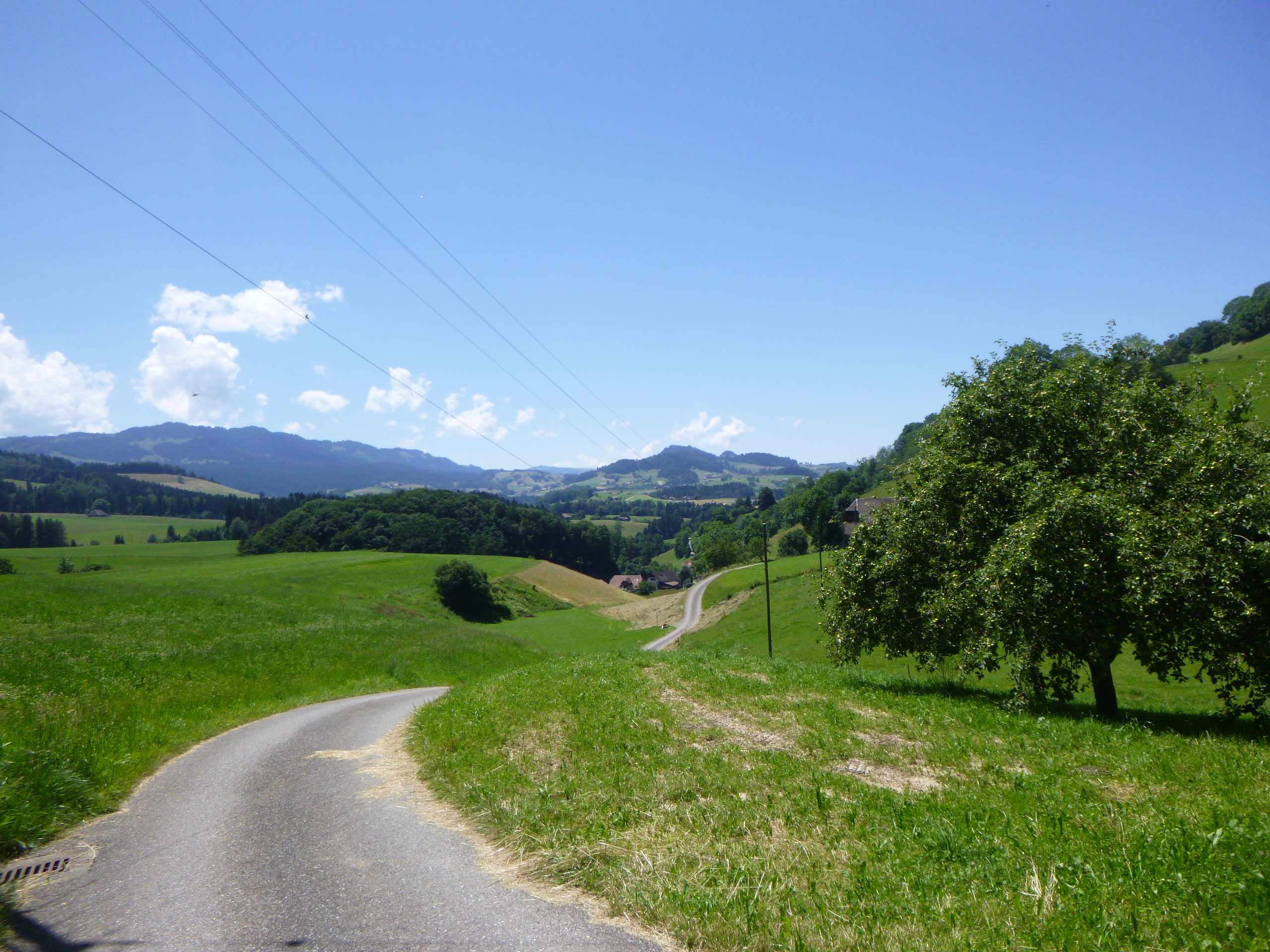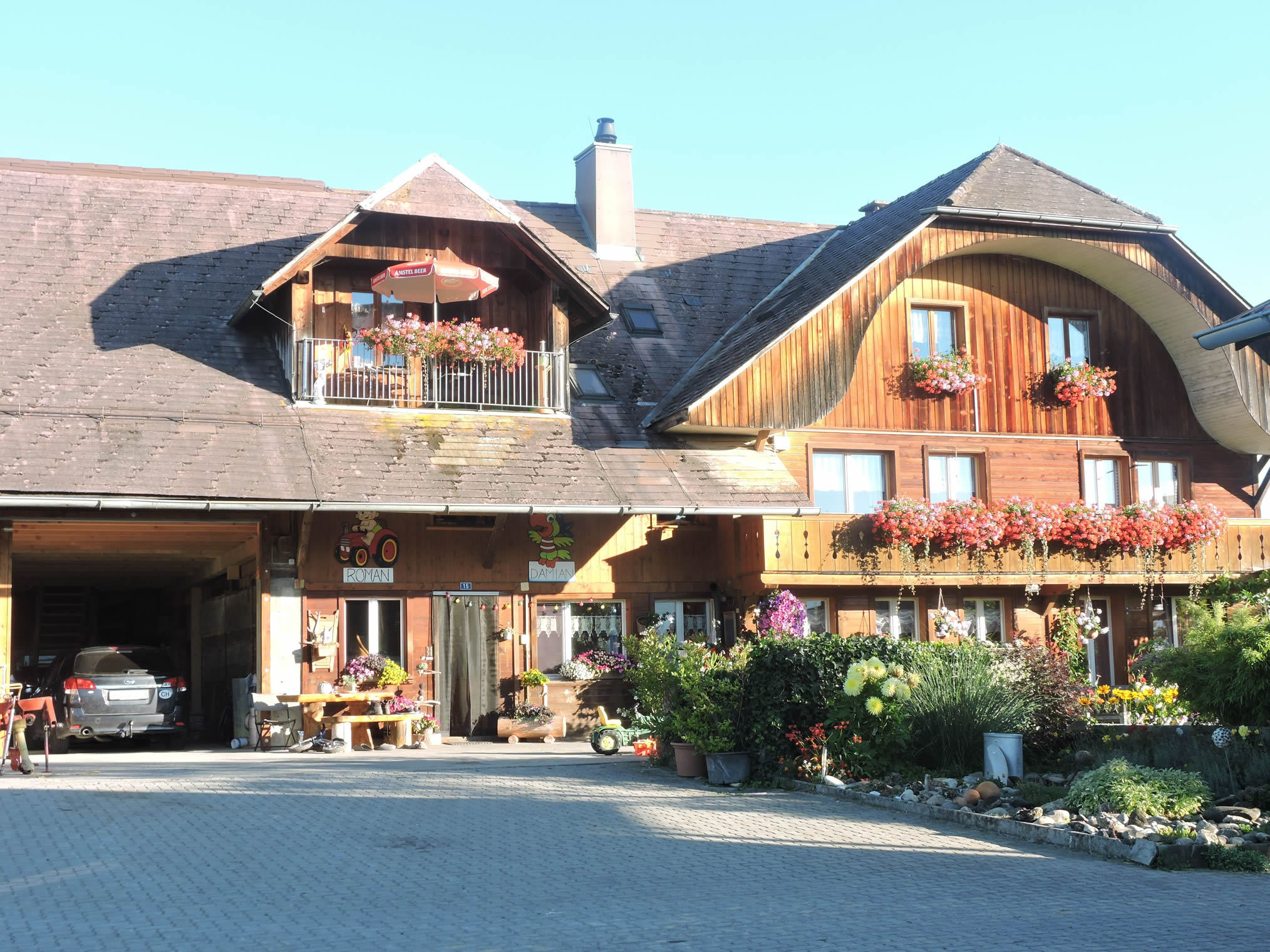In the final foothills of the Canton of Bern
DIDIER HEUMANN, ANDREAS PAPASAVVAS

We divided the course into several sections to make it easier to see. For each section, the maps show the course, the slopes found on the course, and the state of the route (paved or dirt roads). The courses were drawn on the « Wikilocs » platform. Today, it is no longer necessary to walk around with detailed maps in your pocket or bag. If you have a mobile phone or tablet, you can easily follow routes live.
For this stage, here is the link:
https://fr.wikiloc.com/itineraires-randonnee/de-rueggisberg-a-schwarzenburg-par-la-via-jacobi-4-171241659
|
Not all pilgrims are necessarily comfortable using GPS or navigating routes on a mobile device, and there are still many areas without an internet connection. For this reason, you can find several books on Amazon dedicated to the major Via Jacobi 4 route, which runs through the heart of Switzerland and over the Brünig Pass. The first guide leads pilgrims through the German-speaking part of Switzerland up to Fribourg, while the second continues through French-speaking Switzerland to Geneva. We have also combined these two books into a compact, lighter, and highly practical version. While the descriptions have been slightly condensed, they remain detailed enough to guide you step by step along the way. Recognizing the importance of traveling light, this latest edition has been designed to provide only the essentials: clear and useful information, stage by stage, kilometer by kilometer. The stages have been carefully adjusted to ensure accessibility and alignment with available lodging options. These books go beyond simple practical advice. They guide you kilometer by kilometer, covering all the crucial aspects for seamless planning, ensuring that no unexpected surprises disrupt your journey. But these books are more than just practical guides. They offer a complete immersion into the enchanting atmosphere of the Camino. Prepare to experience the Camino de Santiago as a once-in-a-lifetime journey. Put on a good pair of walking shoes, and the path awaits you.
|

|
 |
If you only want to consult lodging of the stage, go directly to the bottom of the page.
Today’s journey starts through the last hamlets of the Thun district before delving into the countryside and picturesque villages of the Schwarzenburg district. This area is nestled between the winding waters of the Schwarzwasser to the east and the meanders of the Sense to the west. This region holds a unique history, shaped by the sale of its lands in equal parts to the cantons of Fribourg and Bern by the Dukes of Savoy in the 15th century. Thus began the austere era of dual rule, a period that lasted until 1798, leaving its mark on this small, isolated territory often steeped in poverty, as neither Bern nor Fribourg were inclined to invest significantly in its development. It was only with the advent of the 1798 Swiss constitution that Bern was granted total annexation of the Schwarzenburg region, sealing its fate as a Bernese district.
This is a land of gentle hills, dotted with magnificent farms that wrap around the marl cliffs patiently carved by the Schwarzwasser River, forming a rather severe canyon. However, after overcoming this obstacle, fresh air revives on a vast plateau, with the Pre-Alps looming on the horizon. Here, nature reigns supreme, offering a majestic spectacle to those who take the time to stop and admire the raw beauty of this preserved landscape.
This is a very short stage. Indeed, many pilgrims travel directly from Bern to Schwarzenburg without stopping in Rüeggisberg. However, this makes for a very long and challenging stage with significant elevation changes. This choice, although daring, reflects the endurance and determination of the walkers, ready to face the challenges of the road to reach their destination.
From Rüeggisberg onward, the stages are the same whether you were following the traditional Via Jacobi 4 through Central Switzerland, the most traveled route, or the Via Jacobi 4 coming from Luzern via Bern. To allow you to follow the route in a linear fashion, we have therefore also included these stages up to Geneva on the website.

Difficulty level: The elevation changes (+159 meters/-277 meters) are moderate, but the stage is brief. The only significant difficulty here is climbing up from the Schwarzwasser canyon to the plateau. The descents, on the other hand, pose little challenge.
State of the Via Jacobi: As usual, the roads stand out by dominating the paths through the heart of nature:
- Paved roads: 5.7 km
- Dirt roads : 4.7 km
Sometimes, for reasons of logistics or housing possibilities, these stages mix routes operated on different days, having passed several times on these routes. From then on, the skies, the rain, or the seasons can vary. But, generally this is not the case, and in fact this does not change the description of the course.
It is very difficult to specify with certainty the incline of the slopes, whatever the system you use.
For those seeking « true elevations » and enthusiasts of genuine altimetric challenges, carefully review the information on mileage at the beginning of the guide.

Section 1: In the Schwarzwasser Valley

Overview of the route’s challenges: This route presents no major challenges and is mostly downhill.

| As you leave Rüeggisberg, the route passes in front of the church and through the cemetery… |
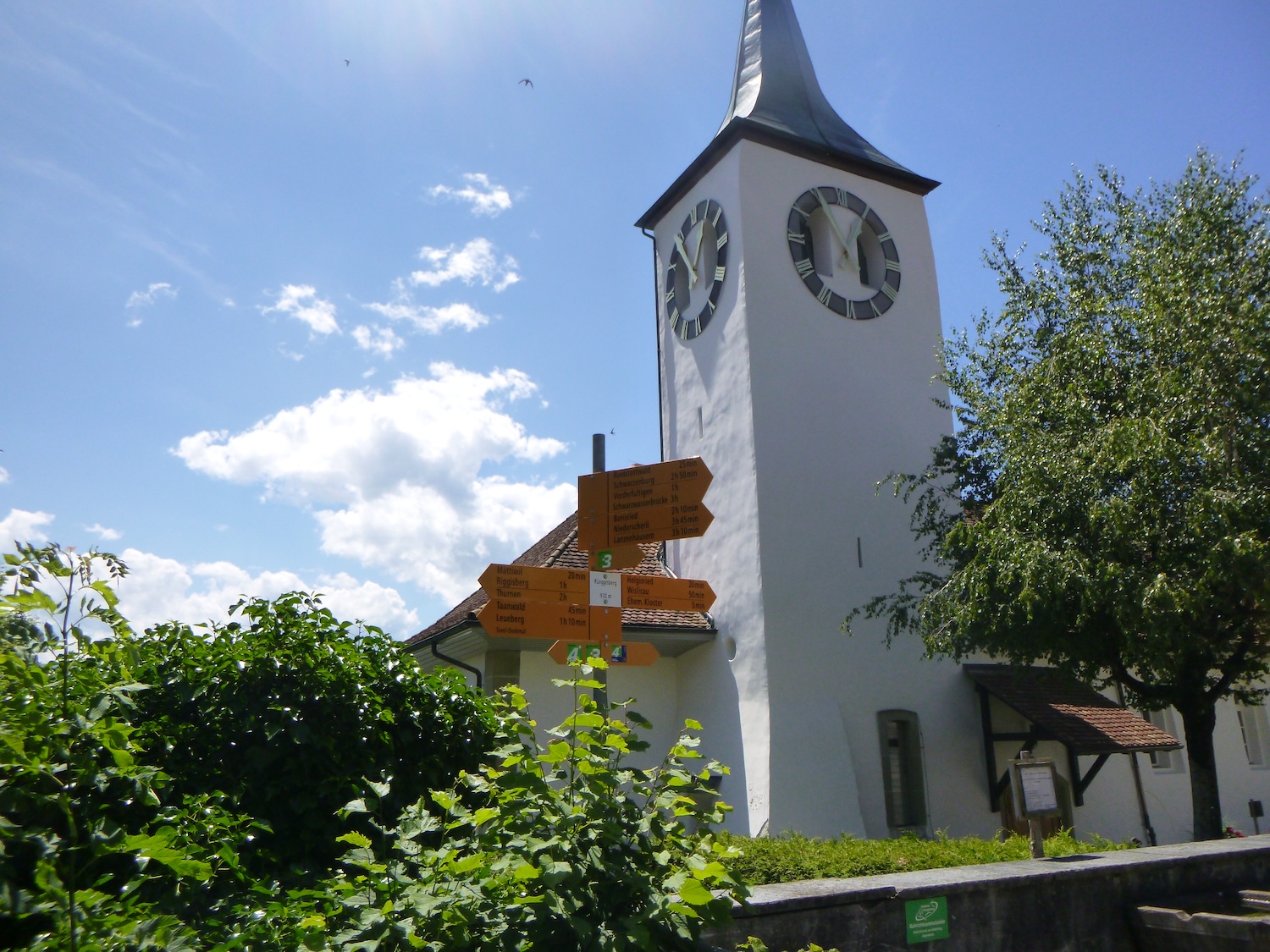 |
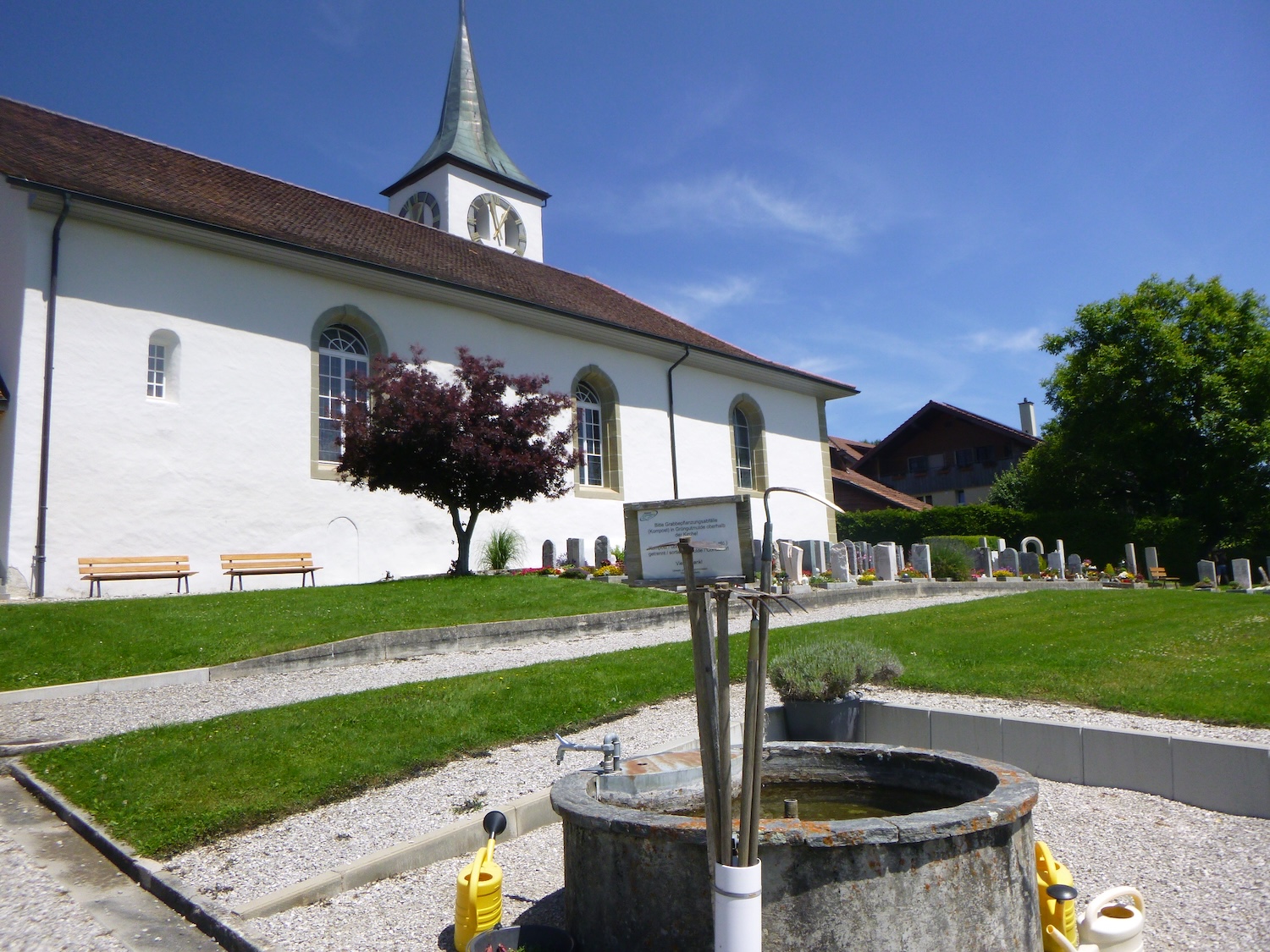 |
| …heading towards the old priory. |
 |
 |
|
This priory once served as an important stop on the Camino de Santiago, though it is less so today. The ruins have been maintained and restored. On a Swiss scale, this site holds significant historical importance, demonstrating the reach of Cluny into the most remote parts of Europe.
|
 |
 |
 |
 |
| St Martin Church dates back to the late 11th century in terms of its foundation. At that time, Baron Lütold von Rümligen donated this church to the Abbey of Cluny to establish a monastery there. It was the first important Cluniac priory in German-speaking Switzerland and also the oldest established in Bernese land. The church and its dependencies (including the cloister) were built in the architectural style of Cluny II. The convent complex was imposing, and the church, with 3 naves and a transept, ended with a series of 5 Romanesque apses, likely very beautiful. The rights of landownership, justice, and even ecclesiastical rights extended far and wide. The domain also included alpine pastures. There remains a farm on the site. The city of Bern increased its influence and eventually incorporated the Cluniac priory into the chapter of Saint Vincent of Bern. After the Reformation, in 1541, the convent buildings were dismantled persistently, although some remains of the North transept endured, and the site long served as a quarry. |
 |
 |
 |
 |
The route then leaves the cloister, at the corner of the farm.
| Once you leave these remains, nature awakens in all its splendor, becoming alternately wild and enchanting. A trail winds into lush forests, weaving between century-old trees and dense, untamed bushess. |
 |
 |
| Lower down, the trail meets the rushing stream of the Grüenibach. |
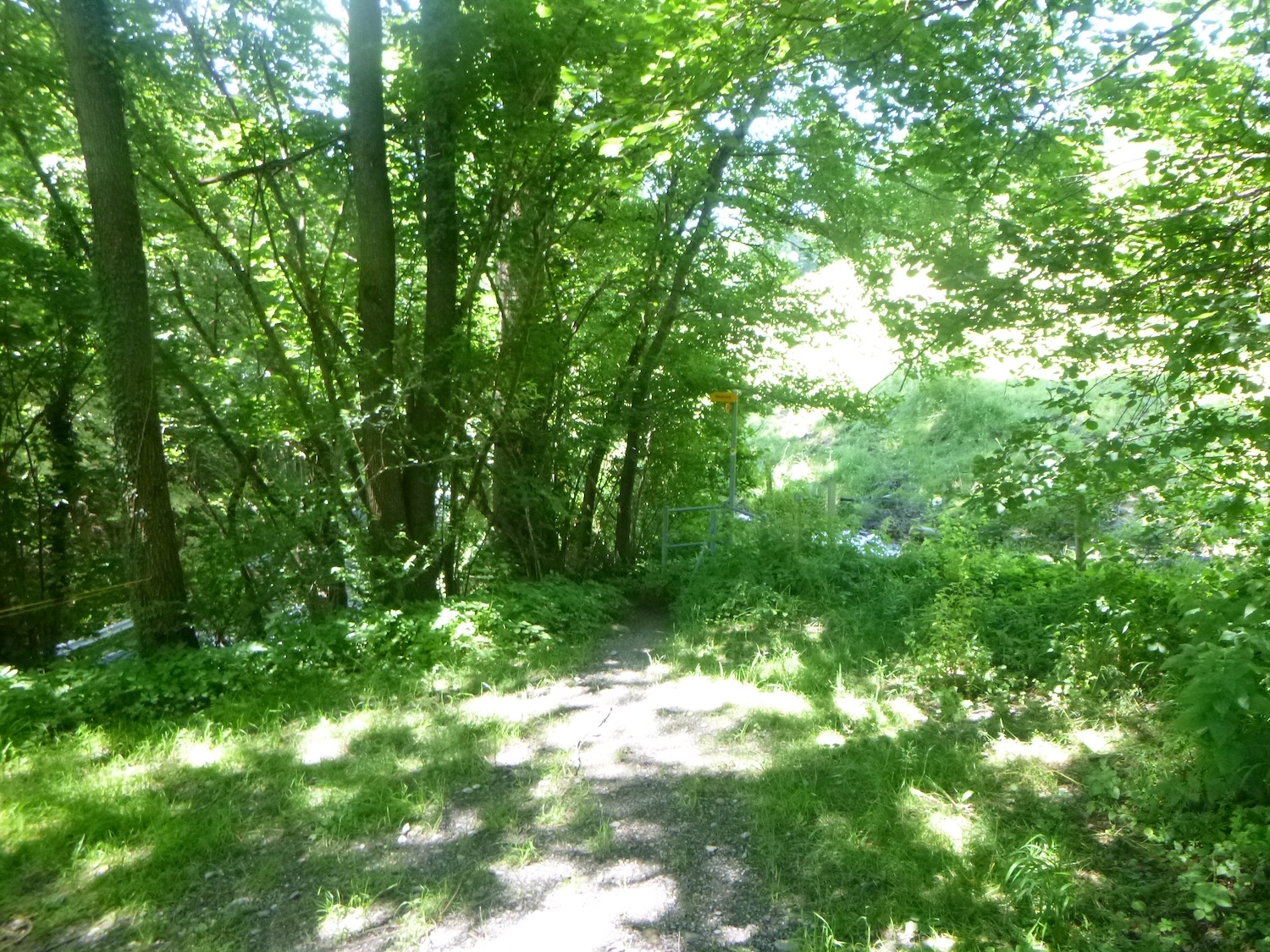 |
 |
| At the bottom of the descent, over unsightly wooden logs, the trail joins the cantonal road descending from Rüeggisberg. |
 |
 |
| This part of the journey is far less exciting, along the road. But the penance is brief, and quickly the Via Jacobi returns to another bad trail plunging back into wild depths, to avoid a bend in the road. |
 |
 |
| The descent becomes steep, through tall grass that weaves a dark dome over the trail. |
 |
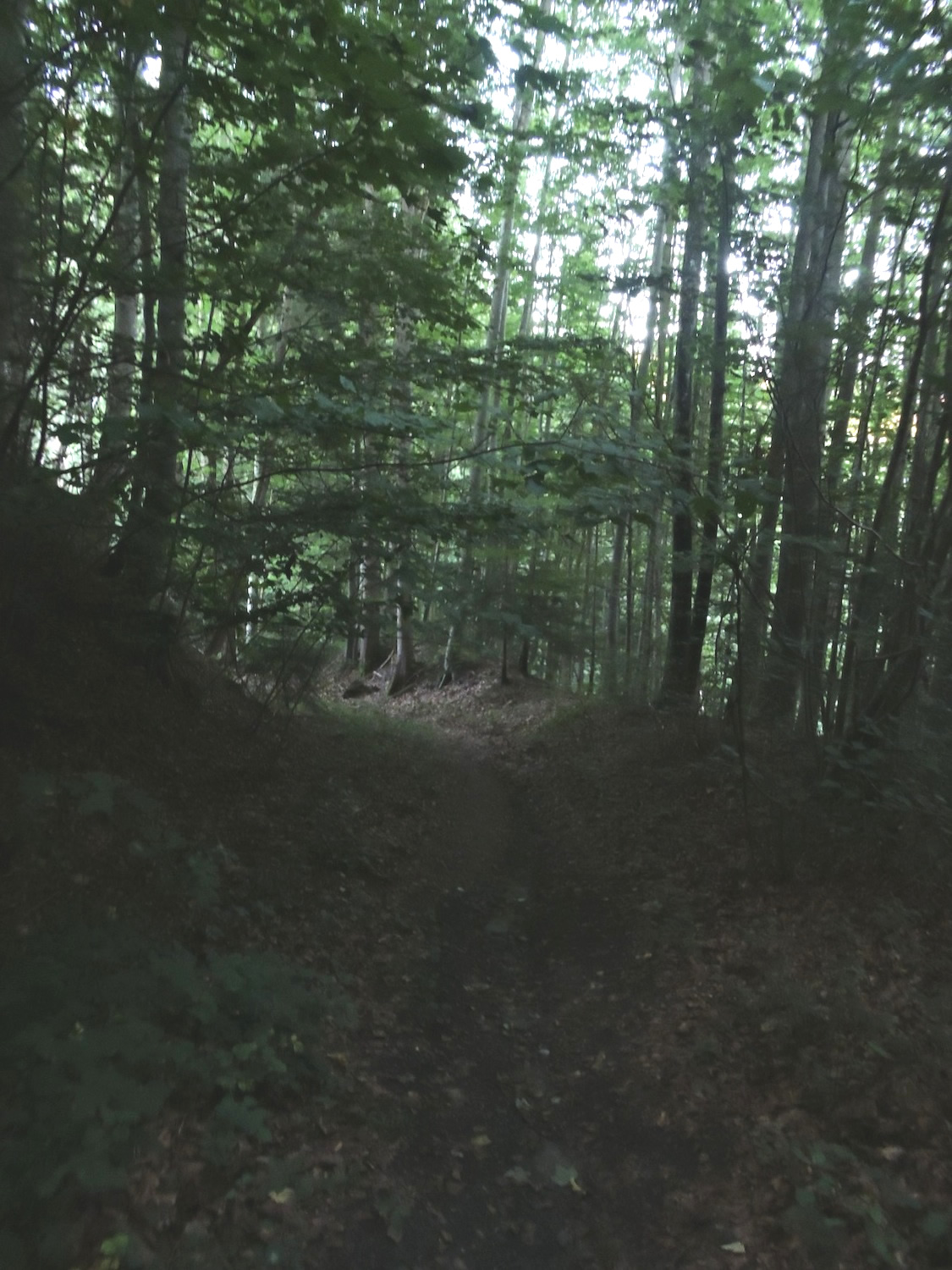 |
| At the bottom of the dale, the trail crosses the Grüenibach stream again before regaining the calm of the road. |
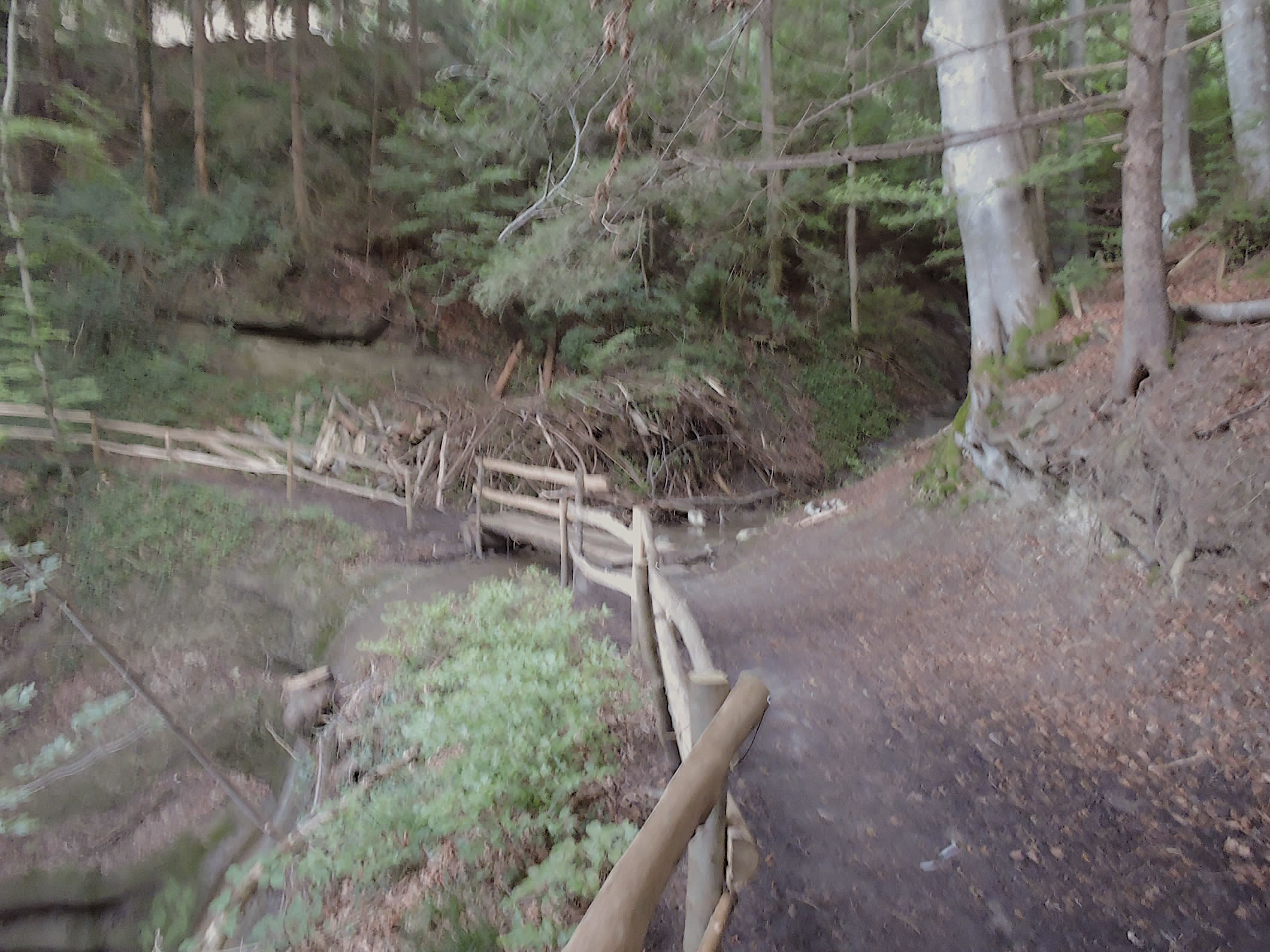 |
 |
| The Via Jacobi continues along the road to Helgisried, where vast farms stand proudly, silent witnesses to an ancestral tradition. Here, every detail tells the story of a community deeply attached to its roots, sometimes with the trophies of competitions won by the owner. |
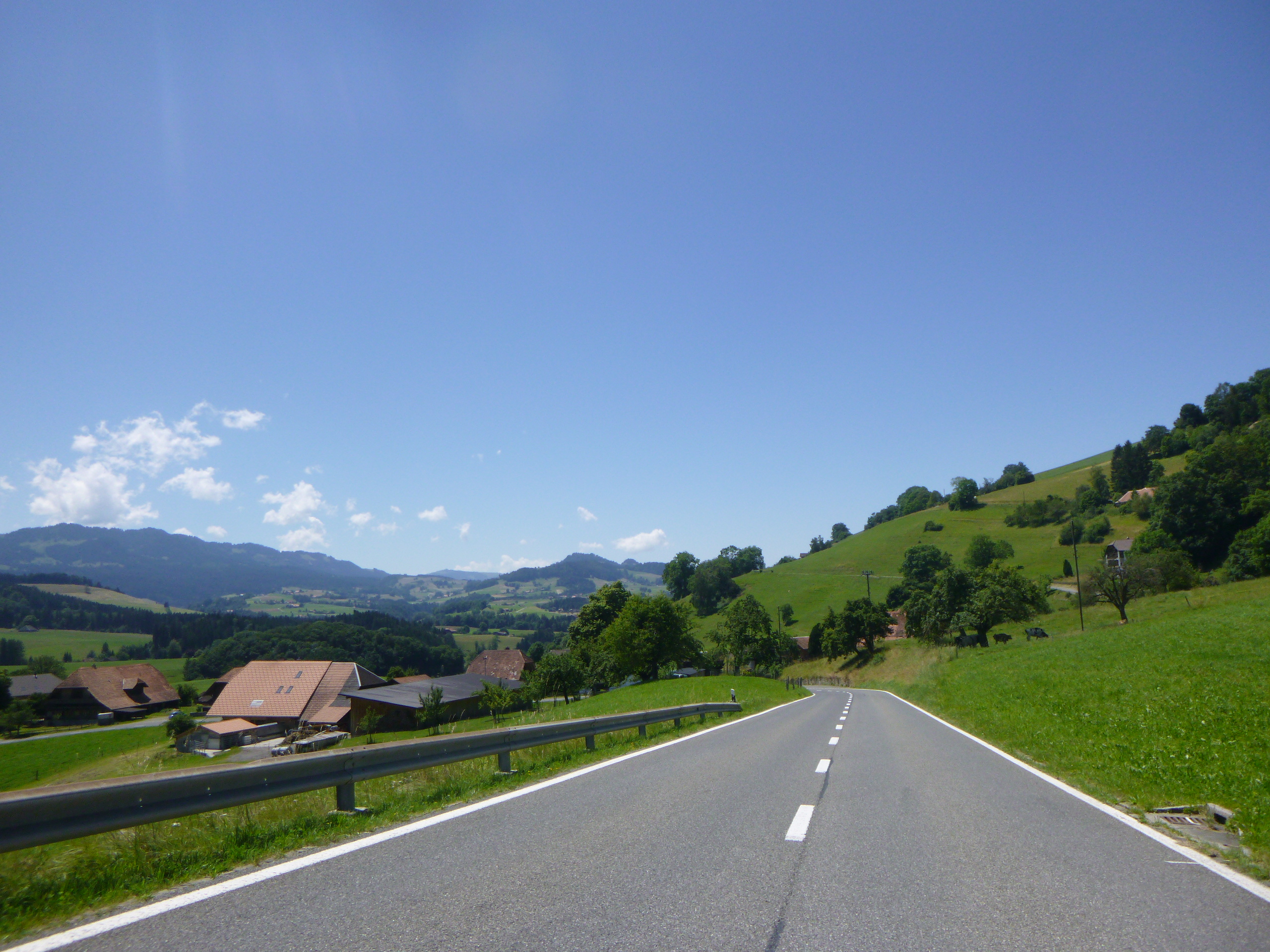 |
 |
You are now 30 minutes from Wislisau, where you will find the Schwarwasser river.

| At Hegelsried, around a majestic farm, the Via Jacobi takes a small road winding through the countryside towards the isolated hamlet of Matten. |
 |
 |
On the turn of a peaceful road winding through green meadows, a true bucolic painting of the Matten countryside unfolds.
| Lower down, like a symphony of nature, the Via Jacobi detaches from the paved ribbon to venture into a ballet of wild grasses toward the Schwarzenburgstrasse, the main thread of this rural setting. In this landscape waltz, the path then heads toward the houses of Bühlstutz. The murmur of the cantonal road below accompanies their silhouette.
Here are a few autumn images bathed in phantasmagoric fog. |
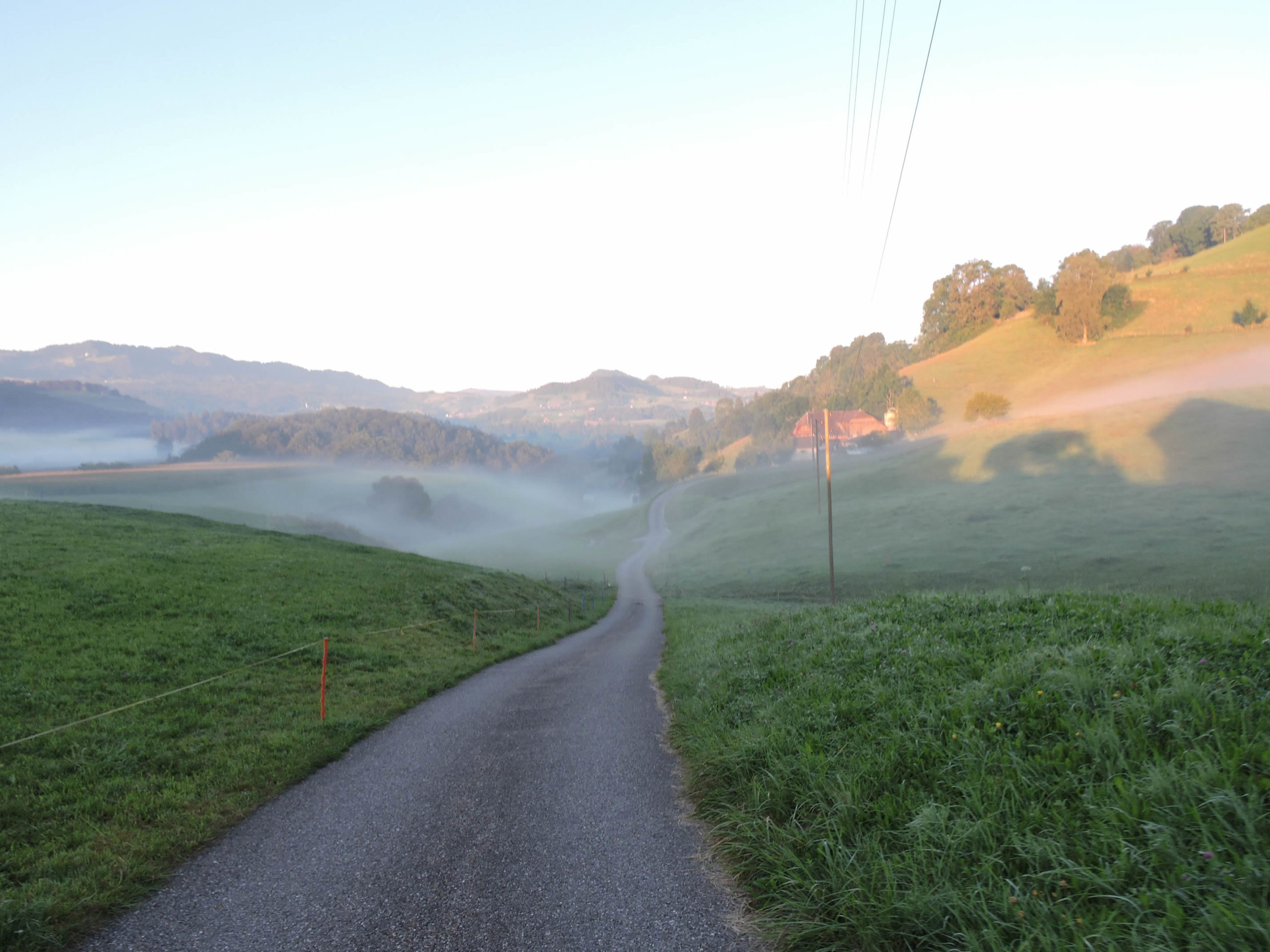 |
 |
| The houses of Bühlstutz, like pearls scattered along the edge of this ribbon of civilization, are drawn with touching simplicity against the backdrop of the surrounding nature. A school, which must bring together children from neighboring hamlets, completes the scene. |
 |
 |
| Then, like a poem in motion, the Via Jacobi, faithful to its whimsical destiny, escapes once again, taking a less-traveled road, like a dancer twirling toward the heights where the hamlet of Rohrbach calls it. |
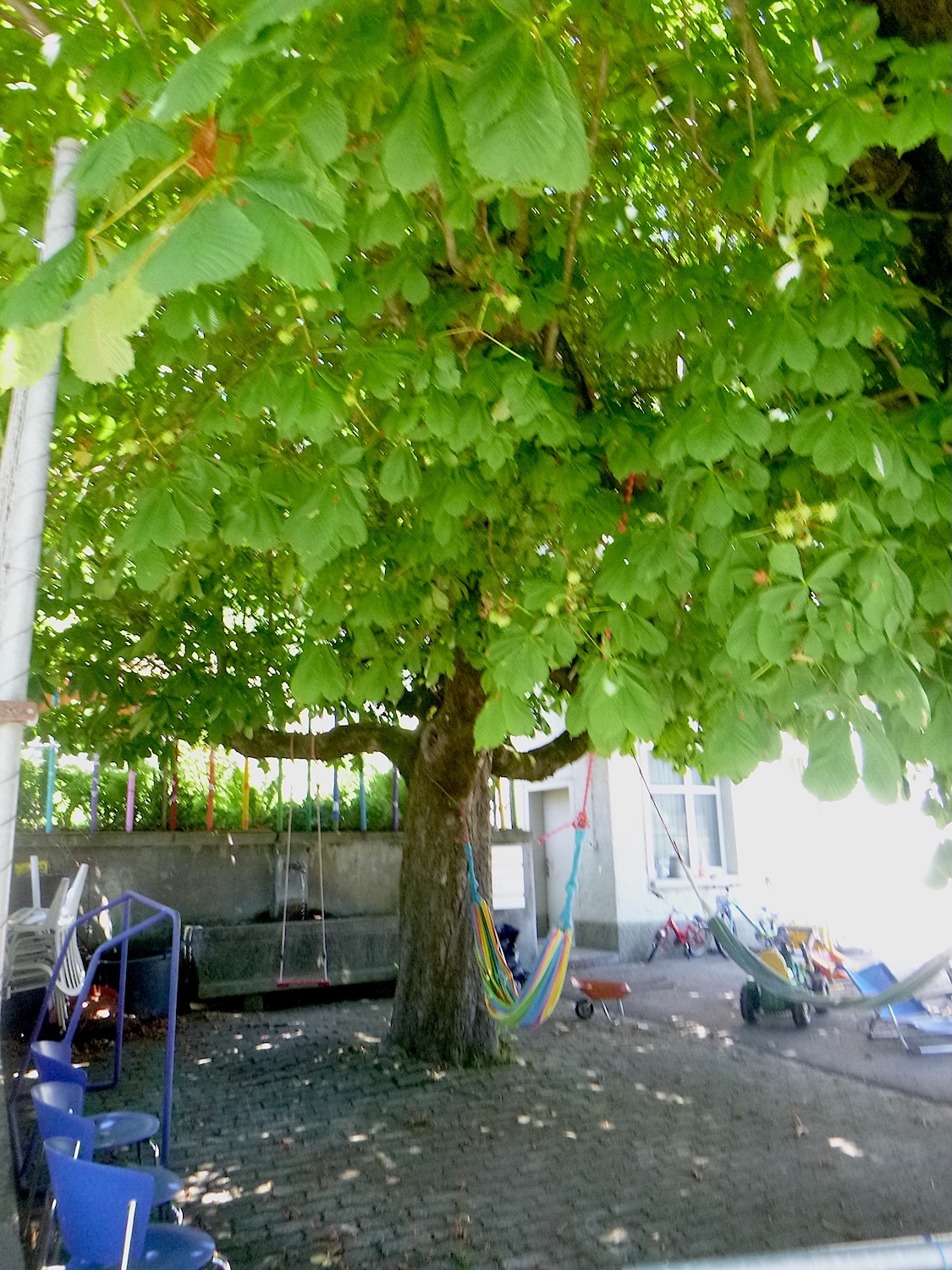 |
 |
| The ascent, steep but fleeting, reveals both the effort and the reward in a single breath. |
 |
 |
| Today, the first rays of the sun caress the hillsides. Above the cantonal road, the ascent, as abrupt as it may be, reveals the raw beauty of this preserved landscape. The farms, oases of life in this wild setting, emerge like sentinels, occupying a space that nonetheless appears limited. |
 |
 |
| The road climbs even higher, past the farms, but the route decides to descend back into the plain, first on the asphalt. |
 |
 |
| Then, through the meadows, a path sneaks, gracefully crossing the fences that punctuate its way, like gates to the unknown, barriers meant to contain the livestock’s tumult. |
 |
 |
| At Sagi, the path reconnects with the cantonal road, allowing travelers to contemplate the rustic charm of the Schwarzenburgstrasse, near which stands a jewel of a patrician farm. |
 |
 |

| The Grüenibach still murmurs its secrets, a natural melody in this enclosed valley vibrant with life and mystery. |
 |
 |
| The road quickly arrives at Wislisau. It’s here that a true hidden gem of this enclosed valley reveals itself: a restaurant where locals gather, a real haven of conviviality in the heart of nature. The soft melody of the river accompanies conversations and clinking forks. |
 |
 |
Here flows the Schwarzwasser, a fierce river dancing on the stones. The murmur of the wild river resonates in the molasse canyon, in the beauty of nature.

| Continuing its journey, the Via Jacobi crosses the Wislisaubrücke, which spans the Schwarzwasser and then frolics in the wild nature along the river. |
 |
 |
| From this bridge, a path blends into the woods, a mix of deciduous and coniferous trees, as if to celebrate the world’s gentleness. |
 |
 |
Section 2: A steep climb before the gentle countryside

Overview of the route’s challenges: a steep hill before reaching the flat calm.

| Then, as if by magic, the path abandons the river to rejoin the cantonal road, offering travelers a breathtaking view of the surrounding terrain. |
 |
 |
| In this greenery, the Via Jacobi veers off the cantonal road to cross the peaceful Lindebach stream, seemingly frozen in the eternity of Swiss landscapes. Be careful here if you’re used to the Camino de Santiago shell markers from France’s paths. In Switzerland, the shell never indicates the direction. One must follow only the Via Jacobi 4 signposts. |
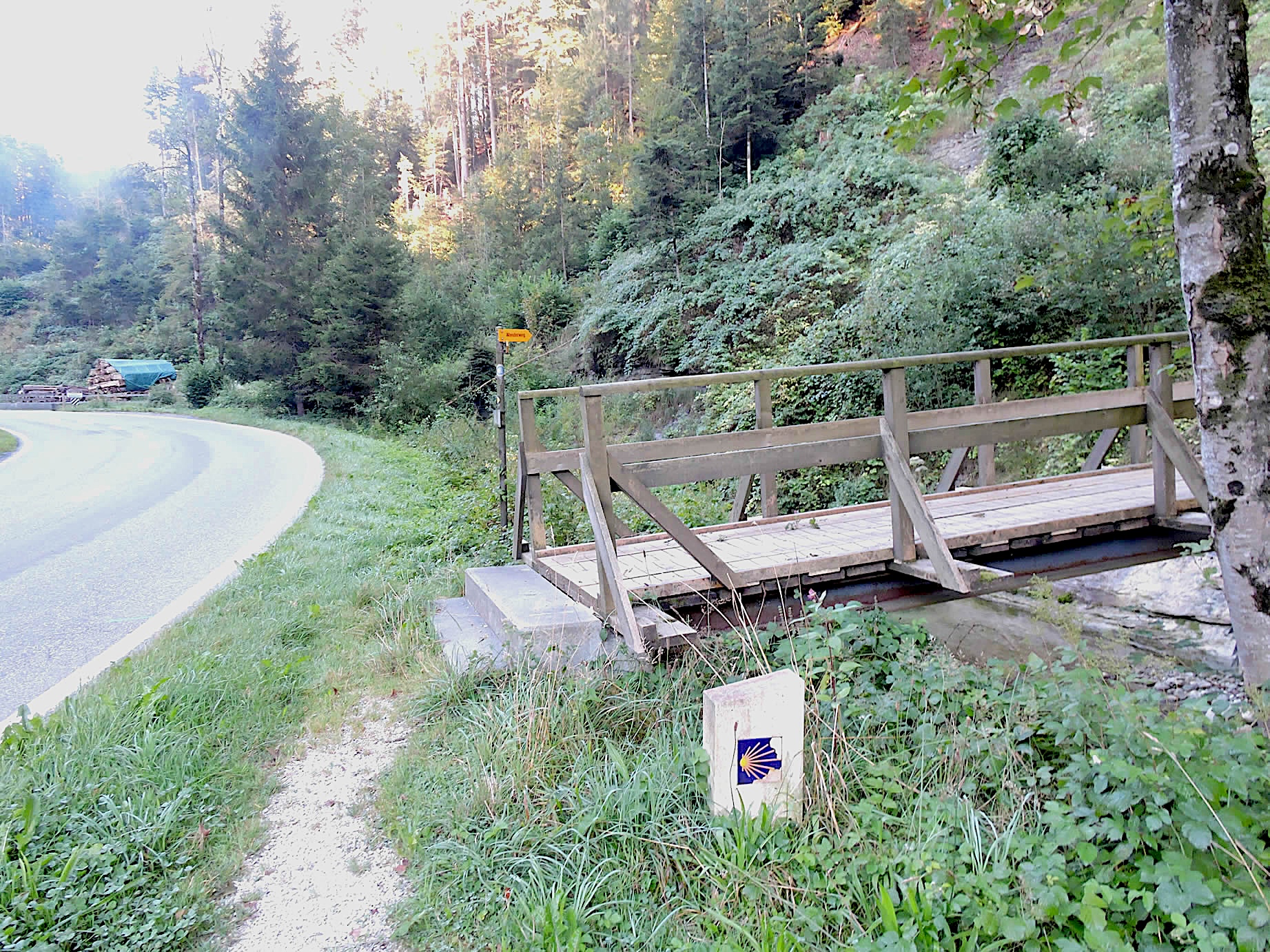 |
 |
| Then, like a tightrope walker on the thread of its destiny, the path climbs, steep in its first steps, an exhilarating challenge through thickets and woods, where every step is a dance with nature. The ascent is severe, with slopes reaching nearly 20% at the beginning, often on wooden logs to prevent slipping. |
 |
 |
| As the climb continues, the trees open up to a clearing bathed in light, like a reward for the effort made. Up there, almost at the summit of the hill, life seems suspended in perfect balance, where shadow and light vie for the privilege of caressing the enchanting landscapes. |
 |
 |
Like an irresistible call, the Via Jacobi sets off once again, attacking the hill with unwavering determination, challenging the steep slopes.

| Over the seasons, the landscape transforms, shifting from shadow to light with infinite grace. In the canyon’s depths, the darkness reigns supreme, while at the summit, the sun today ignites the sky with its radiant beams. |
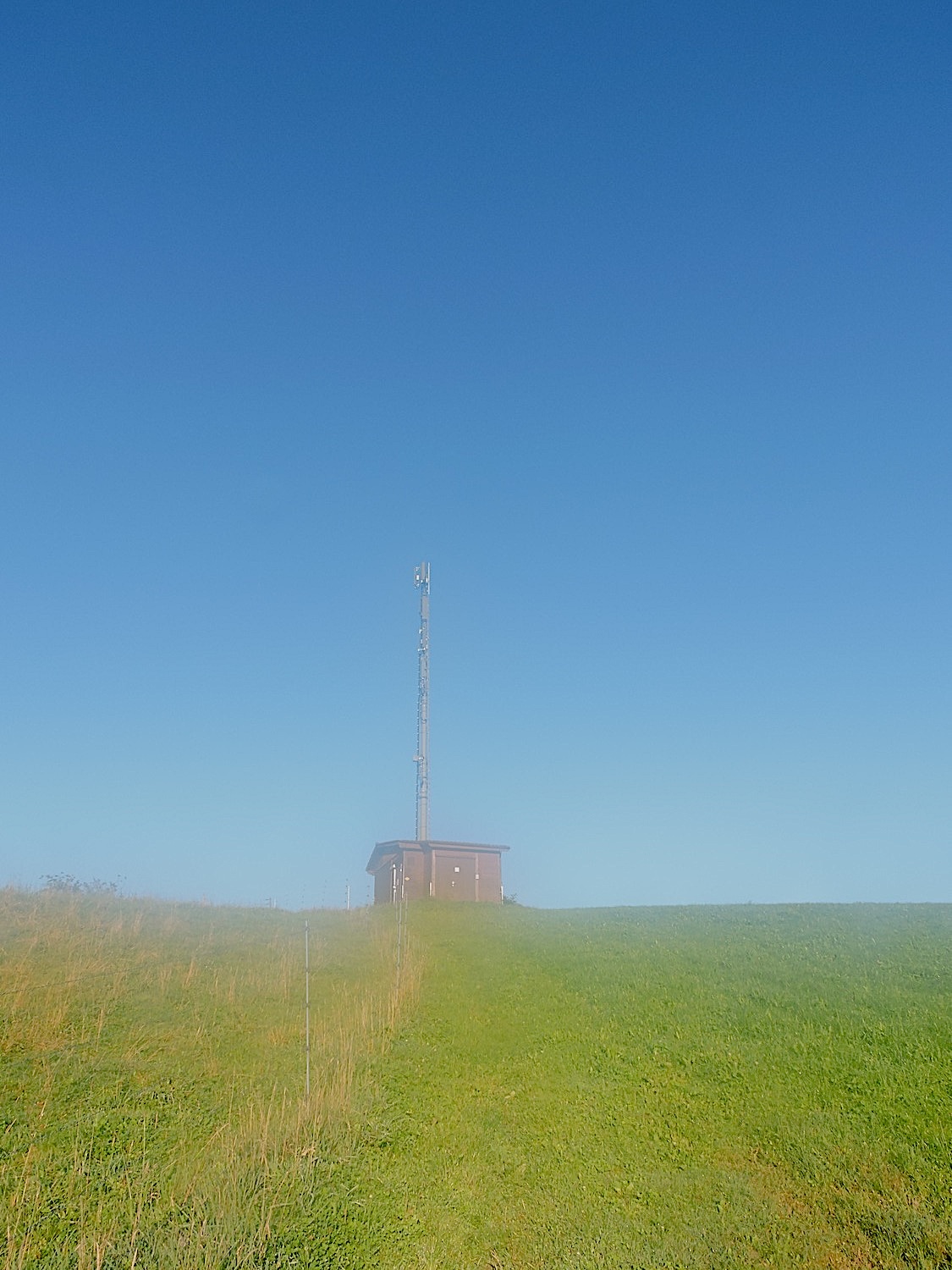 |
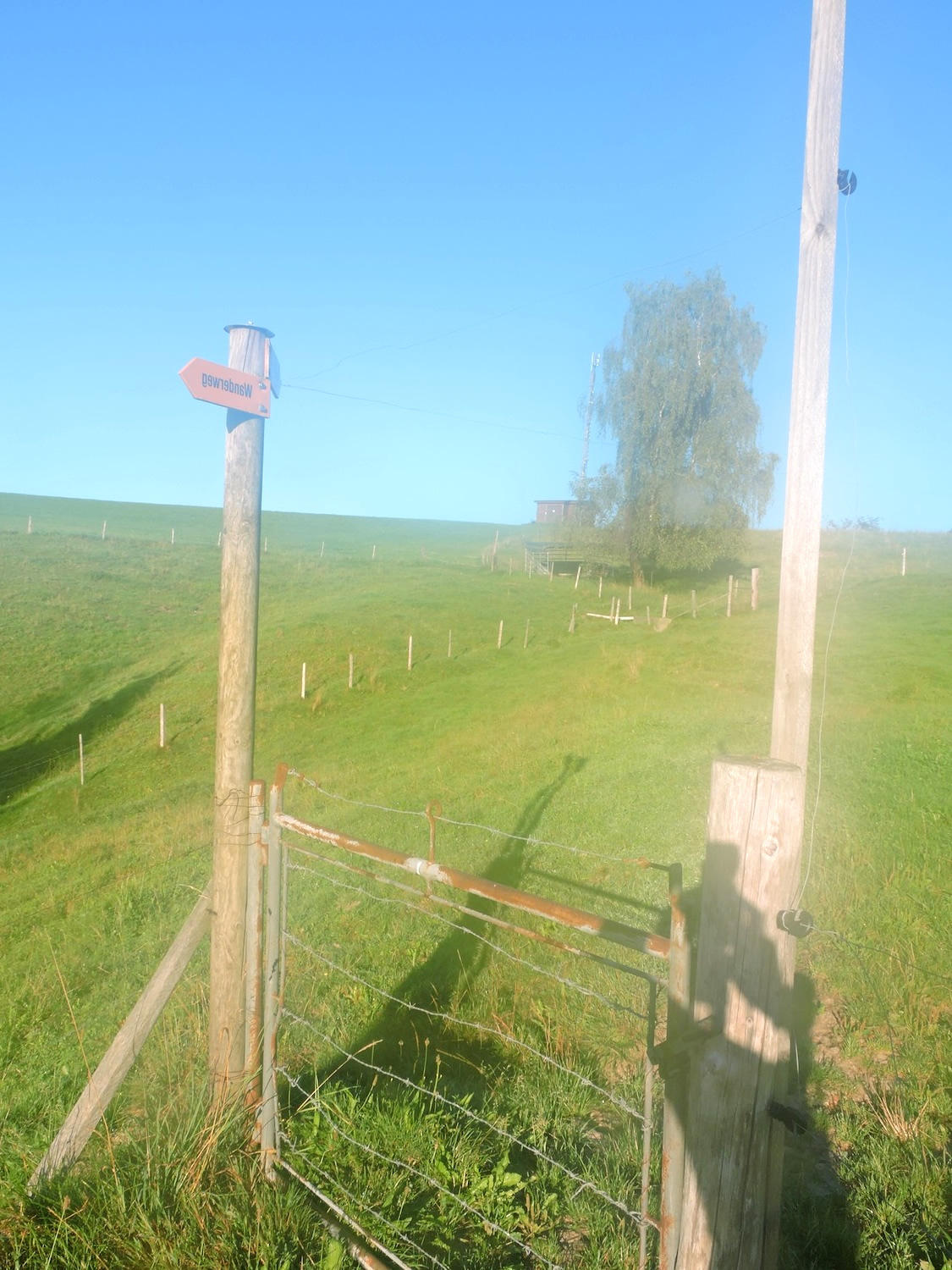 |

| At the summit of the hill, the Via Jacobi offers a breathtaking spectacle. As far as the eye can see, the meadows stretch out, bathed in golden light. In the distance, the place called Granegg, where more than just cows are raised, emerges, a true oasis in the heart of this wild nature. |
 |
 |
| On the small road crossing the plateau, life flourishes in all its splendor. Among the few cornfields and verdant meadows, the farms rise like guardians of time, silent witnesses to the flow of life. The farms are too numerous to count. |
 |
 |
| And then, as if appearing out of nowhere, the farms of Henzischwand stand proudly, like jewels in the countryside’s setting. Surrounded by flowers and greenery, they celebrate the simple beauty of country life, where cattle reign supreme and nature is queen. |
 |
 |
|
Along the well-trodden paths of pilgrims, a bucolic symphony emerges where nature intertwines its notes with the peaceful life of farms scattered along the road. The graceful dance of cows and goats, like playful deities, seems to orchestrate an enchanting ballet on the heights of Kühmoos, while the farms, like jewels set in the verdant fabric of the countryside, offer their serenity to walkers.
|
 |
 |
| With each step, the landscapes reveal themselves with crystalline clarity, where the farms stand in neat rows, bearing witness to the harmony between man and the land that nourishes them. Here, no disgrace mars the horizon, where even the dog droppings are removed, leaving an immaculate purity that caresses the senses and enchants the wandering soul. |
 |
 |
| Far from the artifices of the modern world, the countryside stretches out in all its splendor, unrolling a green carpet and its cornfields. Further on, the dirt road takes place, witness to the footsteps of those who have tread these lands for centuries. |
 |
 |
| The dirt road will stretch for a while between meadows and cornfields. |
 |
 |
In the distance, the Fribourg Alps begin to appear. Gradually, yoe approach the French-speaking region of Switzerland.

| The journey continues, meandering through the twists and turns of the landscape, until the road reaches the entrance of Elisried. Here, you are 45 minutes from Schwarzenburg on foot. |
 |
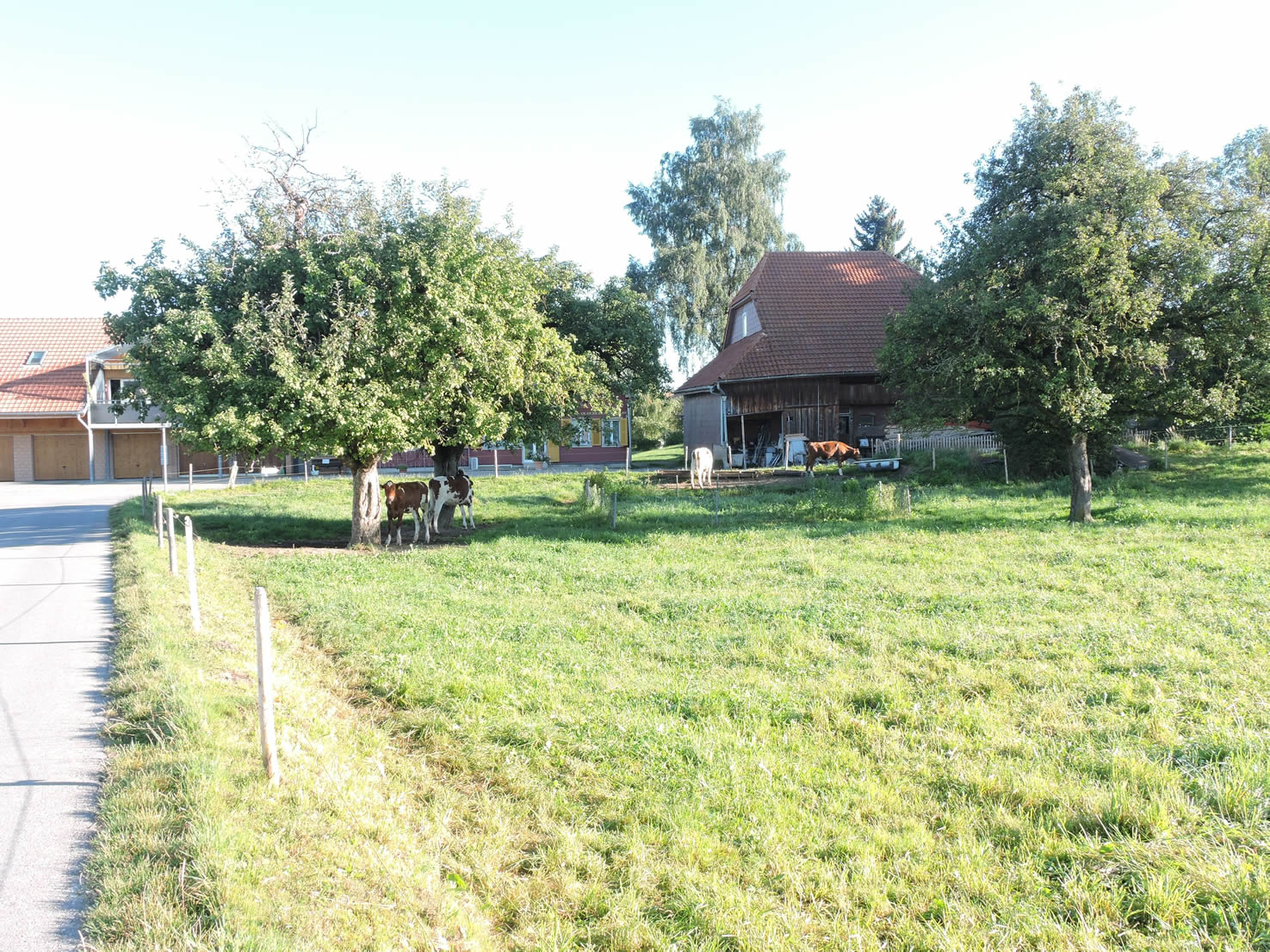 |
There, a call to simplicity resonates, as a generous homeowner opens the doors of his home to travelers, offering them lodging in a cozy bed of straw. This is where the authentic charm of Swiss hospitality resides, enveloping the traveler in a warm embrace, far from the tumult of the modern world.
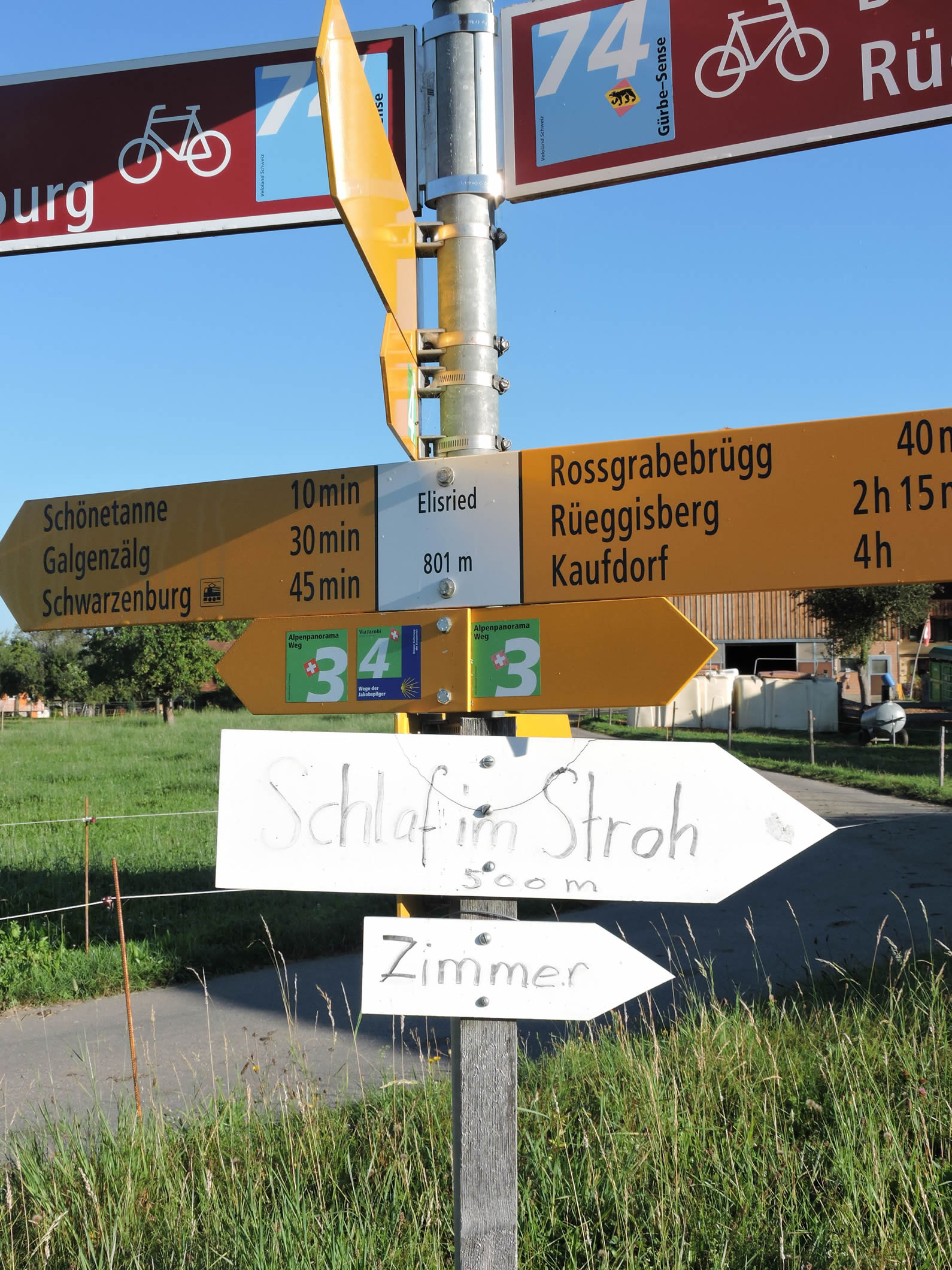
| In this pastoral scene, where every element seems to have been painted by the hand of an inspired artist, stacks of chopped wood rise like living sculptures, silent witnesses to the daily labor of the inhabitants. |
 |
 |
Section 3: Almost at the end of the Canton of Bern

Overview of the route’s challenges: the route is generally easy, with some challenges near Schönnentannen.

| The road continues until it reaches Schönnentannen, where there was once a restaurant by the roadside. The restaurant appears to be closed today. Who knows? |
 |
 |
| And yet, the Camino de Santiago reveals its capricious nature, inviting the pilgrim to leave the beaten paths to explore unknown territories. This is where the magic of the journey lies, in the possibility of getting lost to find oneself, of losing one’s way to discover oneself. Of course, the cantonal road continues to Schwarzenburg, just a stone’s throw away. But the Camino de Santiago loves to lead the pilgrim away from easy roads. So, it invents a small part in the grass, and on a slope. If you don’t want to wrestle with the tall grass, you can, at the restaurant’s height, take the wide dirt road below the main road. This path will lead you effortlessly to the town.
For others, those who naively believe the Camino de Santiago is unchanging and that it’s good never to detour or take a shortcut, engage in the wrong little staircase. |
 |
 |
It’s a trail that climbs steeply through the meadows to the top of the hill.
| . |
 |
 |
At the top of the ridge, the world seems to stretch endlessly, unveiling Schwarzenburg in all its splendor, nestled in the gentle hills like a precious gem in the heart of nature.

| The path then becomes a confidant, crossing a small grove, inviting the walkers to dive into the heart of nature to rediscover themselves. |
 |
 |
| In the clearing, the path transforms, blending into the soft grass like a promise of eternity. |
 |
 |
| And when the ridge ends, the road reappears, winding through fields to better guide the traveler to their final destination. With each step, the landscape transforms, offering a constantly renewed spectacle. |
 |
 |
A little lower, you will find yourself above Schwarzenburg, with no trace of the route. Continue confidently through the meadows or descend into the forest. If you can’t find the path, take the road. Schwarzenburg is just below.
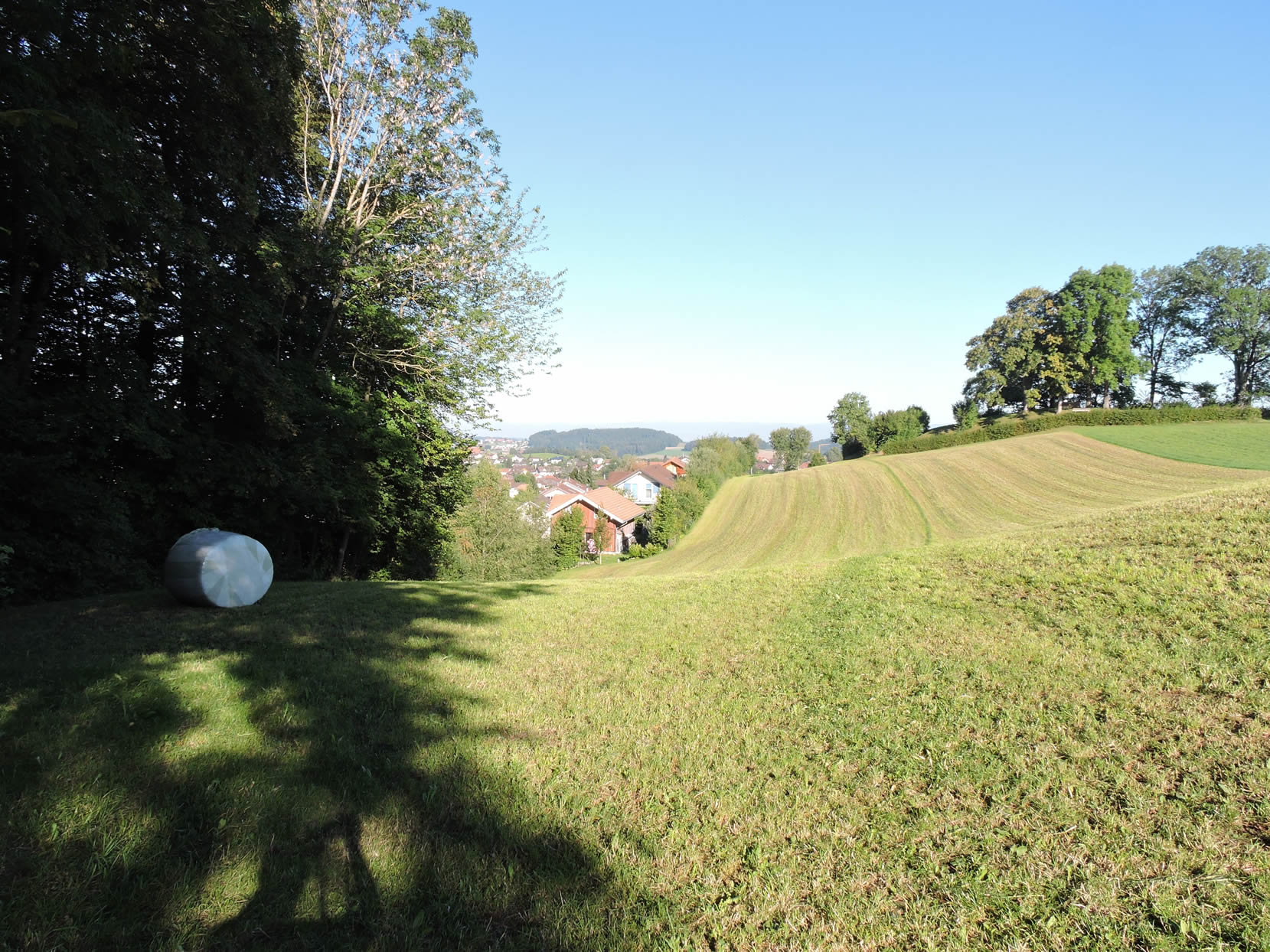
| Schwarzenburg is a small town with nearly 7,000 inhabitants and all kinds of shops. The train also passes through here. The town is dotted with beautiful patrician houses. |
 |
 |
| In the heart of the town, the Dorfbach, like a vital vein, winds through some parts of the center, offering its soothing murmur to passersby. On its banks stand beautiful wooden houses, authentic witnesses of timeless charm. |
 |
 |
| Activity is mainly concentrated around the small shopping streets near the station. The castle, built at the end of the 16th century, is located in a quiet park outside the town. |
 |
 |
Accommodation on Via Jacobi
- Pfadiheim Pöschen, Freiburgstrasse 98, Schwarzenburg; 031 731 20 64; Youth hostel, breakfast
- Mehrzweckanlage, Schwarzenburg; 031 732 01 00; Gîte, breakfast
- B&B Mäder, Katzenstyg 48, Schwarzenburg; 031 731 28 78; Guestroom, dinner, breakfast
- B&B Salzmann, Wartgässli 44, Schwarzenburg; 031 731 28 76/079 627 47 48; Guestroom, breakfast
- B&B Nydegger, Bernstrasse 14, Schwarzenburg; 031 731 15 77; Guestroom, breakfast
- B&B Christen, Zelgweg 34, Schwarzenburg; 031 731 16 45; Guestroom, breakfast
- B&B Schmied, Steinhausstrasse 21, Schwarzenburg; 031 731 05 47; Guestroom, breakfast
- B&B Rebetez, Unters Aebnit 9, Schwarzenburg; 031 731 26 83/079 624 43 34; Guestroom, breakfast
- B&B Leuenberger, Torhalten 1, Schwarzenburg; 031 731 29 75/079 829 95 91; Guestroom, breakfast
- Ausbildingzentrum, Kirchermatt 2, Schwarzenburg; 058 469 38 11; Hotel, dinner, breakfast
- Gasthof Bühl, Thunstrasse 1, Schwarzenburg; 031 731 01 38; Hotel**, dinner, breakfast
- Hôtel Restaurant Sonne, Dorfplatz 3, Schwarzenburg; 031 731 21 21; Hotel***, dinner, breakfast
There are no major difficulties in finding accommodation on this stage. Here, you’ve rejoined the main Via Jacobi 4 route, and the number of available lodgings increases accordingly. You are nearing the end of this stage in a town, with all necessary shops available. Along the route itself, there are no accommodations, but there is a restaurant near the Schwarzwasser. It’s still advisable to book your lodging in advance for peace of mind.
Feel free to add comments. This is often how you move up the Google hierarchy, and how more pilgrims will have access to the site.
|
 |
Next stage : Stage 17: From Schwarzenberg to Fribourg |
|
 |
Back to menu |








































